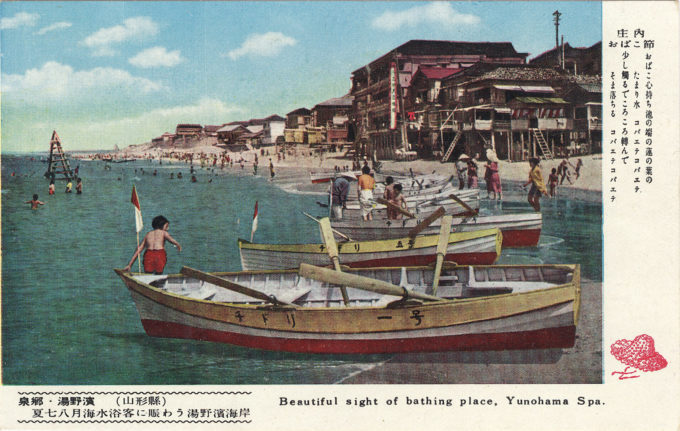
“Beautiful sight of bathing place, Yunohama Spa”, Yamagata Prefecture, c. 1960. Captioned: “Yunohama beach crowded with bathers in summer July and August.”
See also:
Izu Funabara Onsen postcard series, Izu City, Shizuoka, c. 1930.
Onsen (hot springs) culture.
The Natural Sand Baths and Onsen, Beppu, c. 1910-1930.
“Yunohama Onsen, located in Tsuruoka City, Yamagata Prefecture, has a rich history as one of the prominent onsen hot spring resorts along the Sea of Japan coast.
“Its origins trace back to ancient times, and according to local legend, the hot springs were discovered when fishermen noticed an injured turtle bathing in the warm waters and healing itself. This connection to turtles is reflected in the symbolic association of the onsen with longevity and good health.
“Historically, Yunohama Spa flourished as a retreat for samurai and later as a popular spot for travelers seeking the therapeutic benefits of its mineral-rich waters. Its coastal location also made it an attractive destination, blending beach activities with hot spring bathing.
“During the Edo period (1603–1868), the spa became well-known among the ruling elite and local merchants. Over the years, it evolved into a center for relaxation and healing, featuring ryokan (traditional inns) offering ocean views and fresh seafood from the nearby waters.
“The economic recovery of Japan in the 1950s and its subsequent ‘economic miracle’ in the 1960s and beyond saw a surge in domestic tourism. This included trips to hot spring towns like Yunohama Onsen. Improved transportation, such as better road networks and railways, made Yamagata Prefecture more accessible.
“Modernization of ryokan facilities began, although many retained traditional elements to cater to both domestic and emerging international tourists. Yunohama’s ryokan often offered kaiseki (seasonal multi-course meals), emphasizing local ingredients like hatahata (sandfish) and Yamagata’s renowned fresh fruits.”
– Wikipedia

